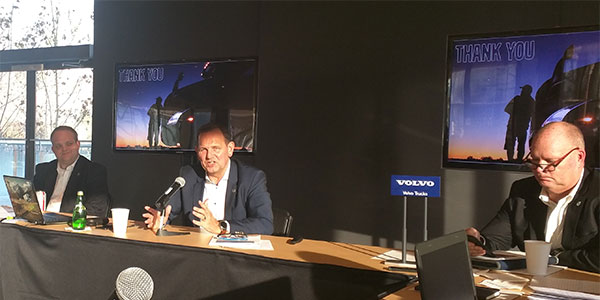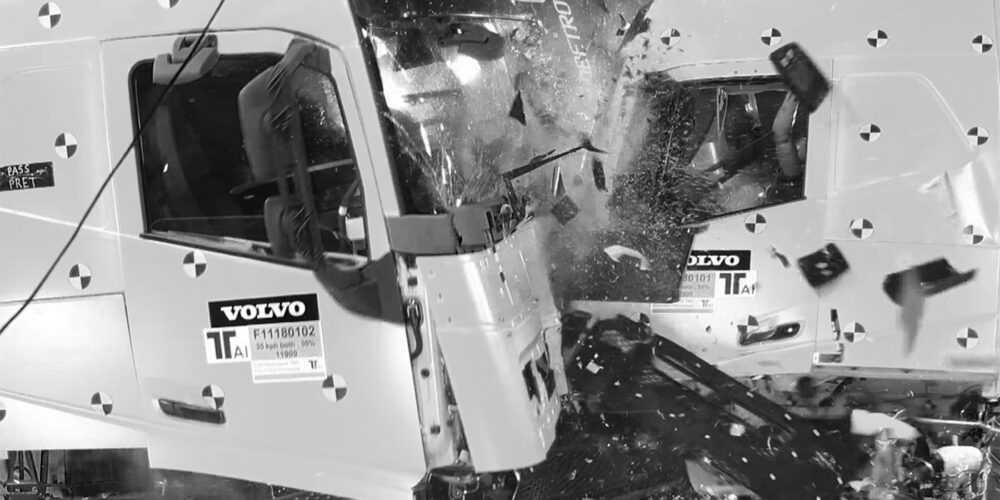
Taking the reins of Volvo Trucks North America as president in September, Peter Voorhoeve stepped into a booming market and a trucking industry in a constant evolution driven by technology. He has spent the past three months crisscrossing the country with the goal of visiting every Volvo Trucks North America dealer to take the pulse of the market and understand the challenges and opportunities at ground level. He also found the time to pull together the North American trade press to talk market strength, Volvo Trucks market share growth and strategy, and make a big electric truck announcement that puts Volvo Trucks North America on pace with several other OEMs that have vowed to bring electric trucks to the market sooner rather than later.
In Volvo Trucks North America’s case, sooner means 2020, as Voorhoeve teased all-electric Volvo VNR regional-haul demonstrators in California next year, operating in distribution, regional-haul and drayage operations, with commercial sales to shortly follow. Voorhoeve is no stranger to tough truck markets, having served as the president of Volvo Trucks Australia from 2013 until he joined Volvo Trucks N.A. this past fall. Already, he knows that a successful electric truck market introduction goes beyond the power unit. There are questions of application, infrastructure and cost cycles—and answering those questions are part of the process of approaching the electric truck opportunity holistically.
Introduction of the Volvo VNR Electric models are part of an innovative partnership known as Low Impact Green Heavy Transport Solutions (LIGHTS) between the Volvo Group, California’s South Coast Air Quality Management District (SCAQMD), and industry leaders in transportation and electrical charging infrastructure.
“In addition to introducing the VNR Electric, through LIGHTS, we will bring a complete sustainable freight solution with end-to-end electrification coordination with our many partners,” Voorhoeve said.

“Thanks to the LIGHTS project, our customers will learn how to operate electric trucks too,” added Magnus Koeck, Volvo Truck’s vice president of marketing and brand management, sitting beside Voorhoeve during the roundtable. “We have daily requests from customers asking, ‘When can I get an electric truck?’ But they don’t know how they’re going to use it. The LIGHTS project will show an end-to-end solution, and they will see how all the electric truck parameters work together. The truck, the charging station—there are a lot of different things that need to happen.”
For Volvo Trucks, evaluating electric powertrain technology and validating applications for electric trucks is a key component of the LIGHTS program.
“From a technology point of view, we’re still using Volvo Group technology,” Voorhoeve confirmed. “And we believe that in the American market—after seeing that our new VNR was so well received—that electric truck applications fall more within that regional segment; we believe that the VNR is the electric truck for North America.
“And, when you go electric,” he continued, “what you’ll see is that the model chosen by customers leans more toward charging at home rather than on a highway service station.”
Both Voorhoeve and Koeck drew parallels to the natural gas truck segment, which has seen an uptick in sales this year driven by incentives, but acknowledged that there are still plenty of unknowns when it comes to electric trucks.
“[Electric truck adoption] will take some time,” Voorhoeve said. “We might see additional business models and yes it’s heavily incentivized. It’s the same reason we have an uptick in natural gas trucks, because of the massive incentives in California, for example. I think we’ll have similar incentives for electric trucks, initially. But, eventually, incentives will go away and electric trucks will have to stand on their own merits.”
As Voorhoeve mentioned, the Volvo VNR Electric demonstration units will be based on the propulsion and energy storage technology currently being used in the Volvo FE Electric—the cab-over European trucks that Volvo showed off this past summer—and builds on the Volvo Group’s accumulated expertise in electrified transport solutions; sister company Volvo Buses has sold more than 4,000 electrified buses since 2010.
Volvo Trucks is also keeping an open mind during the development of its electric powertrain platform.
“We are evaluating lots of different options,” Koeck said. “Everyone realizes that batteries are important and you can do that in a lot of different ways. We are exploring all the options—we don’t exclude any options and we don’t say: ‘This is our solution.’ What we’re doing in putting these early trucks on the road is that we’re getting lots of input and data. We have been approached by lots of vendors within the end-to-end solution. When we figure it out, we’ll tell you, but now it’s too soon to tell.”
One thing is certain: The speed at which electric powertrain technology is developing isn’t slowing down.
“What we knew about electric batteries a year and a half ago, it’s not valid today,” Koeck added. “It moves quickly. This is just the start.”
More roundtable takeaways
In addition to the Volvo VNR Electric announcement, Voorhoeve and Koeck also talked about the market, the driver shortage and competition from disruptors entering the market. Here’s what they had to say about…
The strength of the market:
Voorhoeve: “The markets are strong, and we’re riding that wave. Volvo Trucks is improving its performance in these strong markets. Our order intake was up 44% and we delivered 17% more trucks—as a rule of thumb you always want more orders than deliveries; when you have more deliveries than orders, you start sliding down.
“Talking about North America numbers, it was 300,000 units in 2018. I think we’ll see a bit more than 300,000 units next year. Our prediction is for 2019 is that the market will continue to be strong, and might be a little bit stronger even, at 310,000 units. Canada, the U.S. and Mexico will continue to grow. I think it has to due to the fact that the U.S. economy is as strong as it’s ever been, and the strong order levels will continue in 2019.”
Volvo Trucks’ market share:
Volvo trucks gained Class 8 market share this year, with a year-to-date market share of 10.2% within the NAFTA markets, up from 8.2% in 2017. Within the U.S. specifically, Volvo touted a 10.6% market share, up from 9.4 in 2017. Volvo Trucks’ proprietary powertrain continues to perform well within its builds with Volvo power making up 92% of builds and the I-Shift automatic manual transmission earning 88% of all Volvo Trucks North America builds.
What does that mean to Voorhoeve?
“Market share: How do we translate that? Do we talk about volume? Do we talk about market share? For me, to become the world’s most preferred truck brand, you have to talk about being trustworthy and credible. We need to make sure that we’re leading in customer satisfaction; that customers know they can depend on us and we care about them,” he said.
How new truck technology will impact the role of the driver:
Voorhoeve: “Technology will make the driver’s job more interesting. A year ago, when the industry talked about autonomous vehicles and drivers – we talked about Level 5 autonomy without a driver, but that’s not what this is all about. It’s about autonomy, Levels 1 through 5. You’ll see all those levels within different segments, and we are looking at autonomy that supports the driver. All of those levels, working at the same time in different applications, and making the driver more effective and help them become better drivers in terms of safety and fuel efficiency.”
Disruptors who underestimate the ability to produce:
Koeck: “As I always say: We shall not underestimate the skill to build 200,000 trucks. That’s what we do within the Volvo Group. Everyone can build one, or two or 10, but to have an entire supply chain around the world to supply the world with 200,000 trucks, which, by the way, are correctly spec’d for a particular customer in a particular market—across the group—that shall not be underestimated.”













